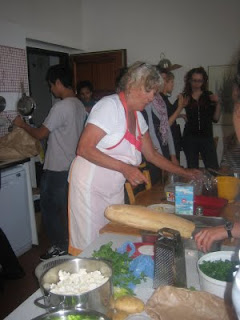Now I have entered into the 2nd week of lesson on this wonderful amazing program. Since part of the program is hosted by the Anthropology department at the UW, there is a historical ethnographic analysis/study aspect to how food ways and Italian culture of eating has been affected by various food politics. During WWII, the italian economy was weak and imbalanced and as a result, most people struggled to eat. Hence a particular genre of Italian cuisine was hatched, la cucina povera (the poor cuisine), and today our class was given a live cooking class by a very charismatic Tuscan who grew up in that period retelling her childhood kitchen experiences and then we went on to prep, cook and eat the cucina povera way, although by the end of this seeming feast our appetites were more than well satisfied. I would marvel at a cooking class about la cucina ricca! Now Italy enjoys a cucina ricca (rich), or benestante (well-off), I guess you would call it these days, which has lead to much revolution for what concerns Italian cuisine and food production which is precisely what we intend to study and understand. And how else would we learn but the hands on way? To cook and eat.
Regional cuisines have been formed and changed due to foreign occupations, politics, time and space. The Sicilian region was occupied and influence for hundreds of years ago by Spain, France, Greece and various Arab countries. As a result, they developed a cuisine typically consisting of eggplant, flatbreads, pinenuts, tart cheeses, chocolate, various spices, stewed meats, etc. This cuisine is still strong to its foreign roots that were present many years ago. Lets hope that Globalization and the Industrialization of food doesn't have as much of a lasting affect on influencing Italian Cuisine.
La cucina povera consisted of a lot of bread, stale bread, water, salt & pepper, modest amounts of olive oil, unleavened chickpea flour, inexpensive vegetables such as cauliflower, potatoes, carrots and spinach, and of course a few eggs and sugar here and there. But apart from the bread and water, everything else is a mere condiment for flavor and perhaps trace minerals.
The menu that we created was:
Dante's Sweet Mess: bell peppers (the sweetness), a few capers (just for savour), anchovies (to give the saltiness to the dish instead of salt itself), and a smidge of olive oil on top of sliced bread. All this pan cooked makes the mess.
La Minestrone- una battuta (a beating. im not sure why the teacher called it this but whatever im not italian) of onions, carrots, celery and oil slowly fried and add then steamed potatoes, chard, spinach and fresh parsley to make the soup. No water added. All the moisture from the steamed veggies make the broth base. This modest concoction is then served upon garlic rubbed (rubbing instead of adding garlic in the soup since garlic was also pricey and needed to be stretched out as much as possible) and drizzled olive oil bread and voila. yummy.
Zuppa di Cavolfiore- simplest delicious soup. Water Broth (made from the stalk and leaves of the cauliflower), a head of cauliflower, salt and pepper. Basta. You then dip a piece of stale bread in the water broth and serve the soup on top.
Farinata di Ceci- an unleavened "bread/flatbread" made only of chickpea flour (very cheap and very filling, a cucina povera prereq.) water, a few drops of olive oil, salt & pepper and a couple sprigs of rosemary. baked and fantastic.
And yes, there was a dessert.
Dolce Pane (sweet bread pudding)- stale bread slices, lemon zest from 2 lemons (not easy work!), a shy handful of raisins, and a beaten egg/sugar sauce to pour over and bake into a bread pudding. We poured a little bit of milk on top of this to be a little more ricca.
Enjoy!
Subscribe to:
Post Comments (Atom)










I cannot believe they call this school!
ReplyDeleteThis pure joy...JEALOUS :)
Bon Appetito!